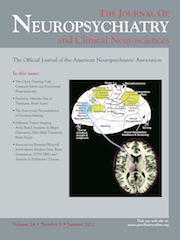Venlafaxine Causing Akathisia: A Case Report
To the Editor: Venlafaxine is a bicyclic antidepressant that inhibits the reuptake of serotonin at all doses, norepinephrine at medium-to-high doses, and dopamine at high doses.1 We report a patient who developed significant akathisia after venlafaxine was prescribed for treatment of depression.
Case Report
A 69-year-old man with mild cortical dementia was admitted to our hospital with a 2-week history of agitation and an 8-week history of progressive restlessness. The past medical history included a left thalamic stroke secondary to a thalamic hemangioma 5 years before admission, with residual right-sided hemiparesis, a fully-resolved right parietal subdural hematoma that occurred 2 years before admission, hypertension, and diabetes mellitus. Three months before admission, he was placed on venlafaxine extended-release formulation (XR) 150 mg for depression. His other medications on admission included metoprolol 25 mg once daily, glipizide 15 mg once daily, metformin 1,500 mg once daily, aspirin 81 mg once a day, and divalproex sodium 250 mg at bedtime. He was seen by his psychiatrist within 2 weeks of starting venlafaxine. At that time, there was no akathisia or restlessness noted on examination.
On admission, he described his symptoms as “miserable” and reported that he was not able to sit still or stand without feeling uncomfortable and restless. He exhibited obvious motor restlessness. His extremity movements were hyperkinetic. These movements were absent when he was asleep. No tremor or other parkinsonian features were evident. The Barnes Akathisia Rating Scale2 score was 6 out of 9, indicating moderate akathisia. His venlafaxine was tapered and subsequently discontinued over a period of 1 week. His akathisia resolved within 3 days of discontinuing the venlafaxine. At the time of discharge, his Barnes Akathisia Rating Scale score was 1, and he noted marked subjective improvement.
Discussion
Venlafaxine-induced akathisia, although rare, has been reported in the medical literature.3 Drug-induced akathisia is usually caused by antidopaminergic antipsychotics, particularly the conventional or non-atypical antipsychotics. The exact underlying pathology of drug-induced akathisia is far from clear, but an association with an altered balance in the dopaminergic system is most plausible. The mesocortical dopaminergic pathway has been suggested as being pivotal in the pathophysiology of akathisia. Tassin et al. were able to produce an akathisia-like syndrome in mice after creating bilateral lesions to the ventral tegmental area.6 Drug-induced akathisia is thought to be product of postsynaptic blockade of this pathway. As reported by Lane, serotonergic and noradrenergic input into the ventral tegmental area may have an inhibitory effect on dopamine transmission and hence lead to hypofunction of the mesocortical pathway.7 This would explain the akathisia caused by venlafaxine and SSRIs. Also, venlafaxine, on rare occasions, has been associated with other types of movement disorders, including parkinsonism, tardive blepharospasm, and neuroleptic malignant syndrome.3–5,7
It is also possible that the patient was a poor metabolizer of venlafaxine. Venlafaxine extended-release is metabolized by CYP 2D6. Preskorn et al. has reported that volunteers who are poor metabolizers because of CYP2D6 polymorphism had higher plasma concentrations of venlafaxine after extended-release administration.8 Thus, the patient may have been experiencing the inhibitory effects of norepinephrine and serotonin on dopaminergic transmission in the mesocortical pathway. It can also be hypothesized that this patient could be predisposed to movement disorders as a result of the history of left-thalamic injury secondary to a hemangioma. Given the anatomical proximity of mesocortical pathway and thalamus; he could have damaged this pathway.
We propose that venlafaxine was the causative agent because of the temporal onset of akathisia after starting the medication and subsequent improvement after the drug was stopped. We also considered other causes of restlessness, such as serotonin syndrome; however, the clinical picture was not consistent with this condition. This case represents an unusual complication of venlafaxine therapy in the context of underlying neurologic deficit. Clinicians should be aware of this complication of venlafaxine.
1 Venlafaxine. Drugdex Evaluations. Micromedex 1.0 (Healthcare series).Greenwood Village, Colo; Thomson Reuters (Healthcare Inc.); accessed on July 27, 2011Google Scholar
2 : A rating scale for drug-induced akathisia. Br J Psychiatry 1989; 154:672–676Crossref, Medline, Google Scholar
3 : Akathisia and abnormal movements of the upper extremities with venlafaxine and methimazole. Gen Hosp Psychiatry 2009; 31:388–390Crossref, Medline, Google Scholar
4 : A critical review of akathisia and its possible association with suicidal behaviour. Hum Psychopharmacol 2001; 16:495–505Crossref, Medline, Google Scholar
5 : A survey of drug-induced extrapyramidal reactions. JAMA 1961; 175:1054–1060Crossref, Medline, Google Scholar
6 : Relationship between the locomotor hyperactivity induced by A10 lesions and the destruction of the fronto-cortical dopaminergic innervation in the rat. Brain Res 1978; 141:267–281Crossref, Medline, Google Scholar
7 : SSRI-induced extrapyramidal side effects and akathisia: implications for treatment. J Psychopharmacol 1998; 12:192–214Crossref, Medline, Google Scholar
8 : Comparison of the pharmacokinetics of venlafaxine extended-release and desvenlafaxine in extensive and poor cytochrome P450 2D6 metabolizers. J Clin Psychopharmacol 2009; 29:39–43Crossref, Medline, Google Scholar



